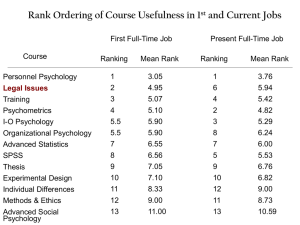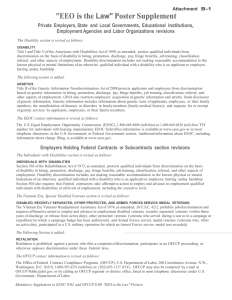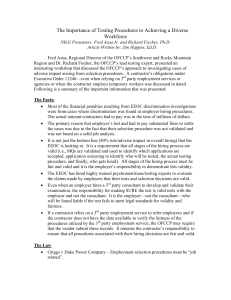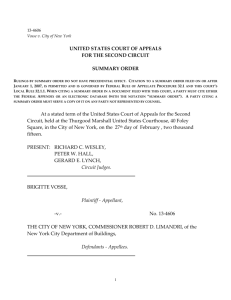Introduction Slides
advertisement
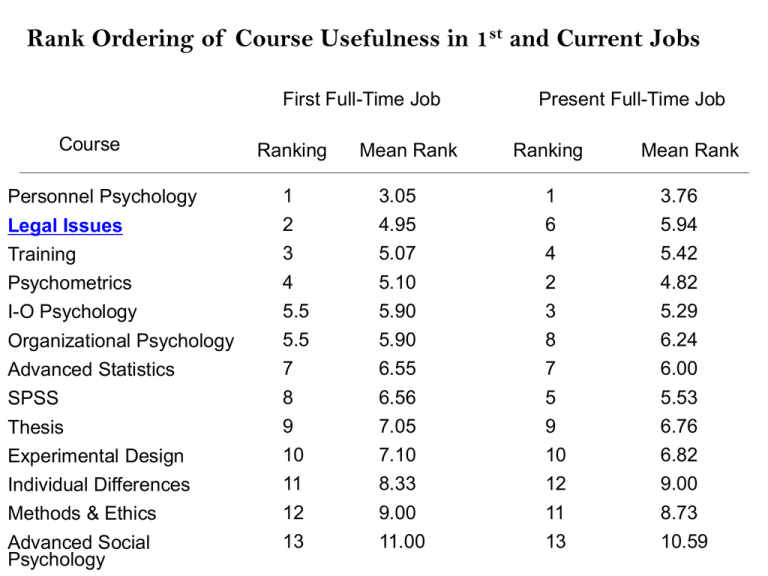
Rank Ordering of Course Usefulness in 1st and Current Jobs First Full-Time Job Course Personnel Psychology Legal Issues Training Psychometrics I-O Psychology Organizational Psychology Advanced Statistics SPSS Thesis Experimental Design Individual Differences Methods & Ethics Advanced Social Psychology Ranking Mean Rank Present Full-Time Job Ranking Mean Rank 1 2 3 4 5.5 3.05 4.95 5.07 5.10 5.90 1 6 4 2 3 3.76 5.94 5.42 4.82 5.29 5.5 7 8 9 5.90 6.55 6.56 7.05 8 7 5 9 6.24 6.00 5.53 6.76 10 11 12 13 7.10 8.33 9.00 11.00 10 12 11 13 6.82 9.00 8.73 10.59 Title VII of the Civil Rights Act 1) Protected Classes: CRA 1964: Race, color, religion, sex, and national TIP article regarding inclusion of sex (http://www.siop.org/tip/jan11/12highhouse.aspx) CRA 1972: Added public sector coverage, gave EEOC power to sue, reduced entities covered from 25 to 15, increased timeframe to file EEOC suit (90 to 180; 210 to 300 days) CRA 1978: Reorganization Plan (e.g., EEOC given authority to enforce antidiscrimination laws for civilian federal workforce and coordinate federal equal employment opportunity programs, passed the PDA, enforcement of EPA and ADEA transferred to EEOC (from DOL) CRA 1991: Clarified burden of proof in adverse impact scenarios, reversed several controversial SC cases, banned test score adjustment based on minority status, allowed jury trials and coverage for expert witness fees 2) Covered Entities: Private, state, local, and federal organizations with 15 or more employees (20 weeks in current or prior year). Title VII of the Civil Rights Act (cont.) 3) Covered Practices: (Non-discrimination – “Trilogy”) • Terms and conditions of employment (e.g. hiring, promotion, firing) • Segregation or classification • Retaliation 4) Administrative Procedures: Primarily by EEOC (also DOJ, DOL) Title VII of the Civil Rights Act (cont.) 5) Remedies: Equitable Relief: (to restore what was lost) --- e.g., reinstatement, back pay for up to 2 years, lost benefits, lawyer fees Legal Relief: Compensatory damages (pain and suffering) Punitive Damages (punish companies for egregious violations; those with malice or indifference). Restricted to private organizations (Monetary caps exist) Prior to CRA-91, only equitable relief was available and decision were limited to judges (jury trials now allowed) Caps for Compensatory and Punitive* Damages Company size (# employees) Damage Cap 15-100 $50,000 101-200 $100,000 201-500 $200,000 501 and more $300,000 * Punitive damages only available in private sector 6) Judicial Scenarios: Disparate treatment, adverse impact, pattern or practice, statutory defenses (e.g., BFOQ, BFSS) Major EEOC Responsibilities Enforcement of the following laws: • • • • • • Title VII of the Civil Rights Act Pregnancy Discrimination Act Equal Pay Act The ADEA The ADA Workplace retaliation Investigates charges of alleged discrimination (and issues findings) Settles charges through conciliation or other informal methods Files lawsuits Develops procedural regulations and issuing interpretive guidelines on various laws Conducts prevention efforts via education and technical assistance programs Total EEOC Charges By Year Claims must be filed within 180 days of the alleged discriminatory behavior in states without EEO laws (non-deferral states), or within 300 days in states with EEO laws (deferral states; a state agency exists). ~ OFCCP Relevance ~ Branch of Department of Labor • Main purpose is to gain voluntary compliance from federal contractors • Administers EO 11246 (Affirmative Action) • Has authority to impose remedies on contractors prior to court action OFCCP has become aggressive in pursuing “class actions‟ • This enforcement has has focused on hiring practices and resulted in record financial settlements. Likely that more I-Os folks are dealing with OFCCP enforcement today than in the past Useful site: OFCCP Blog Spot More on OFCCP in Chapter 7 (Affirmative Action) Sample Settlements (DOL, OFCCP) Overview of OFCCP Investigative Process OFFCP compliance review (e.g., conducts desk audits using EEO-1 and AAP data). Also performs onsite reviews OFCCP attempts to gain voluntary compliance if a contractor is found to be in violation If voluntary compliance fails (no agreement), OFCCP can issue sanctions and fines Contractor can appeal OFCCP ruling; case goes to an Administrative Law Judge (ALJ) from the Department of Labor (DOL) The contractor must then appeal to the Secretary of Labor (and lose) in order to gain access to federal district court In federal district court, contractor bears the burden that a violation was not committed Adapted from: Dunleavy & Gutman, On the Legal Front: OFCCP Settlement Review: What Was the Burden on Bank of America? Get article here ~ Basic U.S. Court System ~ Supreme Court Hears fewer than 100 cases per year of about 10,000 filed Court of Appeals (11 numbered plus the D.C. Circuit and one for the Federal Circuit – 13 total) Total of 179 judges; lifetime appointment. Most cases decided here District Courts (94) Established by Congress; judges serve 10 year terms US Courts of Appeals and US District Courts Map See details of each District Court here Federal Circuit Court of Appeals Map Listing of Federal Circuit Court of Appeals 1st - ME, MA, NH, PR, RI 2nd - NY, VT, CT 3rd - PA, NJ, DE, VI 4th - MD, NC, SC, VA, WV 5th - LA, TX, MS 6th - MI, OH, KY TN 7th - IL, IN, WI 8th - ND, SD, MN, NE, IA, MO AR 9th - CA, OR, WA, AZ, MT, ID, NV, AK, HI 10th - CO, KS, NM, OK, UT, WY 11th - AL, GA, FL DC - DC, Tax Court, fed admin agencies. Federal - Patent, Int'l Trade, Claims Court and Veterans' Appeals. From: Findlaw.com U.S. Supreme Court Background: Court established by Article III, Section 1 of the Constitution: "[t]he judicial Power of the United States, shall be vested in one Supreme Court, and in such inferior Courts as the Congress may from time to time ordain and establish.” The Act also created the federal circuit courts and the federal district courts, the Office of the Attorney General, and granted the President the right to nominate justices for appointment to the United States Supreme Court with the advice and consent of the Senate. In its 1st year, the Court consisted of 6 justices (one Chief Justice and 5 associate justices). The present composition of one Chief Justice and eight Associate Justices was established under an Act passed in 1948 (28 U.S.C. 1) Relatively weak branch of government in the early years Reasons Why the Court Takes a Case? 1) Conflicting opinions between the circuit courts 2) Lower court decision that conflicts with previous Supreme Court ruling 3) Issues of constitutional importance • Congress can pass legislation to legislatively overturn Supreme Court rulings (e.g., CRA 1991, Ledbetter Act, ADAAA) Robert Barnes, Supreme Court correspondent for The Washington Post, will discuss the federal government's most cloistered and least understood institution, and the pivotal role it plays with the political branches in the nation's governance. After its most dramatic change in personnel in decades, the increasingly conservative court will be faced with challenges to President Obama's progressive agenda amid bitter political deadlock in Washington. Controversial issues such as affirmative action, immigration, same-sex marriage, gun control and health care are on the court's horizon. Barnes will also discuss the four youngest and newest justices who will shape its future, and answer questions. The Court Process • The person filing the suit is called the “plaintiff ” • The person or organization against whom the charge of discrimination is made is called the “defendant” Civil Procedures *** 3 phase burden-shifting process 1) Plaintiff must establish a prima facie case Prima facie ”at first look," or "on its face." A lawsuit in which the evidence is sufficient to prove the case 2) Defense offered (non-discriminatory reason - DT, or job-relatedness - AI) 3) Plaintiff rebuttal (pretext - DT, or alternative practice available - AI) Other Key Points • Preponderance of evidence standard (not beyond reasonable doubt – criminal cases) • Summary judgments (e.g., SJD; summary judgment for the defendant) • Class certification; 1) numerosity (large enough; individual claims impractical), 2) commonality (harm common to class), 3) typicality (similar claims among members of class), and 4) protection of class interest (plaintiffs will adequately represent class interests [9th Circuit = Class size of ½ million females; Dukes v. Wal-Mart] Constitutional Amendments and EEO Law • No amendments were designed to relate to EEO laws • Amendments offer broader coverage than Title VII • Some advantages to using amendments (e.g., less restrictions, damages); they fill gaps in Title VII coverage • Amendments often combined with Title VII suits if constitutional claims exist The Amendments & EEO Law Amendment I: Congress shall make no law respecting an establishment of religion, or prohibiting the free exercise thereof; or abridging the freedom of speech, or of the press; or the right of the people peaceably to assemble, and to petition the government for a redress of grievances. >>> Used for discrimination against religion Amendment IV: The right of the people to be secure in their persons, houses, papers, and effects, against unreasonable searches and seizures, shall not be violated, and no warrants shall issue, but upon probable cause, supported by oath or affirmation, and particularly describing the place to be searched, and the persons or things to be seized. >>> Used in cases regarding drug testing The Amendments & Discrimination Law (cont.) Amendment V: No person shall be held to answer for a capital, or otherwise infamous crime, unless on a presentment or indictment of a grand jury, except in cases arising in the land or naval forces, or in the militia, when in actual service in time of war or public danger; nor shall any person be subject for the same offense to be twice put in jeopardy of life or limb; nor shall be compelled in any criminal case to be a witness against himself, nor be deprived of life, liberty, or property, without due process of law; nor shall private property be taken for public use, without just compensation. >>> Protects employees from discrimination by Federal government employers on the basis of race and other classifications Amendment XIII: Section 1. Neither slavery nor involuntary servitude, except as a punishment for crime whereof the party shall have been duly convicted, shall exist within the United States, or any place subject to their jurisdiction. Section 2. Congress shall have power to enforce this article by appropriate legislation. Enforced via the CRA of 1866, 1871 (below) § 1981. Equal rights under the law (CRA of 1866, 1871) (a) Statement of equal rights All persons within the jurisdiction of the United States shall have the same right in every State and Territory to make and enforce contracts, to sue, be parties, give evidence, and to the full and equal benefit of all laws and proceedings for the security of persons and property as is enjoyed by white citizens, and shall be subject to like punishment, pains, penalties, taxes, licenses, and exactions of every kind, and to no other. Example: Patterson v. McClean Credit Union (racial harassment covered) >>> Primarily used in cases of race discrimination (although it’s been interpreted very broadly to include national origin. Sex not included as a protected group • • • • No back pay limitations No minimum requirement of # employees Only covers disparate treatment only (need to generate proof of discriminatory intent) Applies only to private organizations The Amendments & Discrimination Law (cont.) Amendment XIV: Section 1. All persons born or naturalized in the United States, and subject to the jurisdiction thereof, are citizens of the United States and of the state wherein they reside. No state shall make or enforce any law which shall abridge the privileges or immunities of citizens of the United States; nor shall any state deprive any person of life, liberty, or property, without due process of law; nor deny to any person within its jurisdiction the equal protection of the laws. § 1983. Civil action for deprivation of rights (CRA of 1866, 1871) Every person who, under color of any statute, ordinance, regulation, custom, or usage, of any State or Territory or the District of Columbia, subjects, or causes to be subjected, any citizen of the United States or other person within the jurisdiction thereof to the deprivation of any rights, privileges, or immunities secured by the Constitution and laws, shall be liable to the party injured in an action at law, suit in equity, or other proper proceeding for redress, except that in any action brought against a judicial officer for an act or omission taken in such officer’s judicial capacity, injunctive relief shall not be granted unless a declaratory decree was violated or declaratory relief was unavailable. For the purposes of this section, any Act of Congress applicable exclusively to the District of Columbia shall be considered to be a statute of the District of Columbia. >>> Permits employees to sue state and local government; often used to sue municipal agencies (police and fire departments for race and sex discrimination in hiring and promotion decisions) and for reverse discrimination suits ~ Some Legal Abbreviations ~ Aff ’d --- Affirmed Pet., Petr. --- Petition, Petitioner Ann. --- Annotated Pl. --- Plaintiff App. --- Appeals Pt. --- Part Cir. --- Circuit Pub. --- Public Cl. --- Clause Rep. or Repr. --- Reporter Cmt. --- Comment Rev. --- Review D. --- Federal District Court Rev’d --- Reversed Dig. --- Digest Sec. or § --- Section Ed. --- Edition Ser. --- Series Inj. --- Injunction S.J. --- Summary judgment J. --- Journal Subp. --- Supoena Judm. --- Judgment Supp. --- Supplement L. --- Law Tent. --- Tentative n., nn. --- Footnotes Tr. --- Trial Op. --- Opinion Trans. --- Translated Or. --- Order Unif. --- Uniform Legal Citations U.S. Supreme Court Cases Teamsters v. U.S., 431 U.S. 324 (1977) Volume # Petitioner Respondent Reporter Year of decision Beginning page # of case The U.S. Reporter is the preferred cite, but sometimes others are used instead. One is the Supreme Court Reporter. The format for this is: Teamsters v. U.S., 97 S. Ct. 1843 (1977). There is also a Lawyers Edition that is used: Teamsters v. U.S., 52, L. Ed.2nd 396. Format used in book: Teamsters v. United States (1977) 431 US 324 Legal Citations (cont.) Quotations Teamsters v. U.S., 431 U.S. 324, 328 (1977) A second page number can be used to indicate the page location of a quote or specific point of law Legal Citations (cont.) Federal Circuit Court of Appeals Cases Glover v. Johnson, 75 F.3d 264 (6th Cir.1996) Volume # Appellant Appellee Circuit Court Beginning page # of case Reporter Year of decision Format used in the text: Glover v. Johnson (CA 6, 1996) 75 F.3d 264 The terms Appellee v. Appellant are used in the Court of Appeals. Therefore, it is possible that the order of the parties in the original case may be reversed. For instance, in a case that started as Johnson v. Glover may be reported as Glover v. Johnson in the Court of Appeals reporter. Federal Circuit Court of Appeals Reporters • Federal Reporter (Cited as F.) – 1880-1924 • Federal Reporter, 2d series. (Cited as F. 2d) 1924-1993 • Federal Reporter, 3d series. (Cited as F. 3d) – 1993 + Legal Citations (cont.) Federal District Court Cases Glover v. Johnson, 478 F. Supp. 1075 (E.D.Mich.1979) Volume # Respondent Petitioner Reporter District Court Beginning page # of case Year of decision Overall, there are 94 federal judicial districts, The number of districts vary within each State. Some states have only one district (e.g., Arizona, Colorado, Delaware), while others have multiple districts (e.g., California, Florida, Texas). Legal Citations (cont.) Statutes --- Session Law Civil Rights Act of 1964, P.L. 88-353, 78 Stat. 241 1964). Page # Title of book Popular Name Volume # Year Public Law # or Chapter # Stat. = Abbreviation for Statutes at Large. Session laws are passed during a given legislative session and are published in the order of their passing. These are the most authoritative version of a law (e.g., the actual wording in the session law is controlling). Legal Citations (cont.) Statutes --- Code Means “add the following.” Used to include numbered lists, pages or sections after the first number is stated Civil Rights Act of 1964, 42 U.S.C. §1971 et seq. (1988). Section # or Part # Title of book Popular Name Title # or Chapter # Year of compilation U.S.C. = Abbreviation for U. S. Code. The United States Code is the collection of laws of the United States arranged within 50 topic areas. The U.S. Code is published every six years, with supplements added annually. Citing Sections and Subsections 17 U.S.C. § 102(a)(1) Second sublevel of organization uses numbers Subsection uses lowercase letters A 3rd sublevel uses upper-case letters [e.g., (B)]. The fourth sublevel uses lower-case roman numerals [e.g., VI)]. Each level of organization is contained within separate parentheses. For example: 42 U. S. C. §2000e-2(k)(1)(A)(i)
